Arizona is a haven for reptile enthusiasts, offering a diverse array of lizards that call its arid landscapes home. Among the myriad species found in this southwestern state, lizards in Arizona stand out for their adaptability and intriguing characteristics. From the iconic Gila monster to the elusive Desert night lizard, Arizona hosts an impressive variety of these scaly inhabitants.
Lizards in Arizona exhibit remarkable diversity, ranging from the diminutive Desert horned lizard to the majestic Chuckwalla. Whether camouflaging among desert rocks or basking in the sun’s warmth on sandy slopes, these reptiles play vital roles in the state’s ecosystem. With their agile movements and unique features, lizards in Arizona captivate both seasoned herpetologists and casual observers alike.
Different Types of Lizards in Arizona
Arizona Alligator Lizard
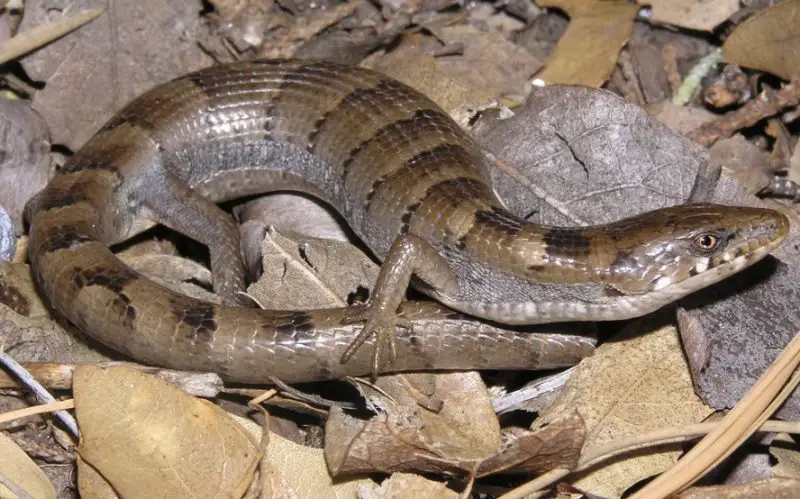
Arizona alligator lizards, scientifically known as Elgaria kingii, are recognizable by their large size, reaching up to 5.5 inches, long bodies, small limbs, and robust tails. Sporting stiff, armored scales, they exhibit tan to gray hues with distinctive red or chocolate cross bands bordered by dark edges. Found in foothills, mountain slopes, and low valleys, these diurnal creatures actively hunt for prey amidst leaf litter and rock piles.
Desert Grassland Whiptail

The Desert grassland whiptail lizard, scientifically named Aspidoscelis uniparens, is identified by its slender body, measuring up to 5.25 inches (13cm), and a notably elongated tail. Sporting a brown or olive body with six distinct yellow lines, its tail transitions to blue or gray. Juveniles boast bright blue tails that fade with maturity. These lizards inhabit desert regions across southern to central Arizona, favoring low valleys, gentle slopes, and grasslands.
Desert Iguana
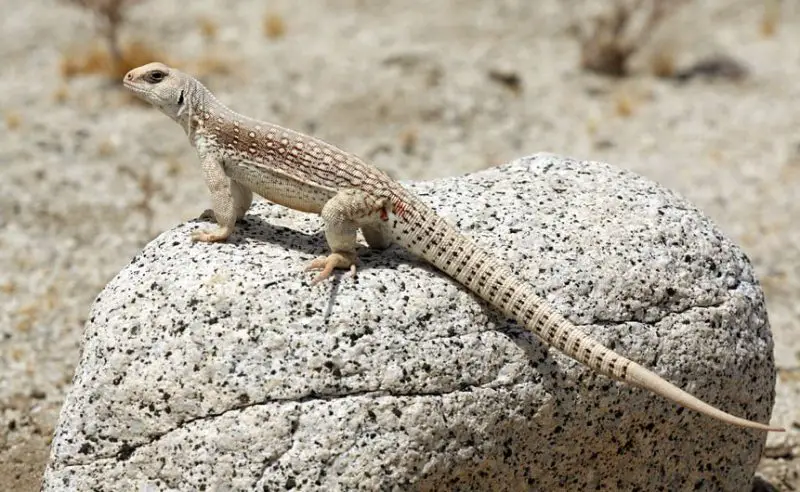
The Desert iguana, scientifically labeled Dipsosaurus dorsalis, reaches lengths of up to sixteen inches (41cm) with a gray to tan body adorned by light brown patterns along their sides and backs. Their tails exceed one and a half times their body length. Thriving in arid, sandy environments, they also frequent rocky streambeds. These resilient lizards endure high temperatures, often remaining active when others seek refuge from the heat. In response to threats, they resort to burrowing beneath bushes for safety.
Females typically reach 5.8 inches, while males are smaller at around 4.8 inches excluding their tails. Remarkably, they can alter their coloration, with spots vanishing during their dark phase and exhibiting various shades of yellow, pink, gray, or brown.
Spiny-Tailed Iguana

The Spiny-Tailed Iguana, scientifically classified as Ctenosaura spp., exhibits varying colors throughout its life cycle. Initially gray to brown with black hues in youth, they transition to lighter shades such as gray or blue, influenced by environmental temperatures. Males reach lengths of 30 inches, while females typically measure around 22 inches, tail included.
Lesser Earless Lizard
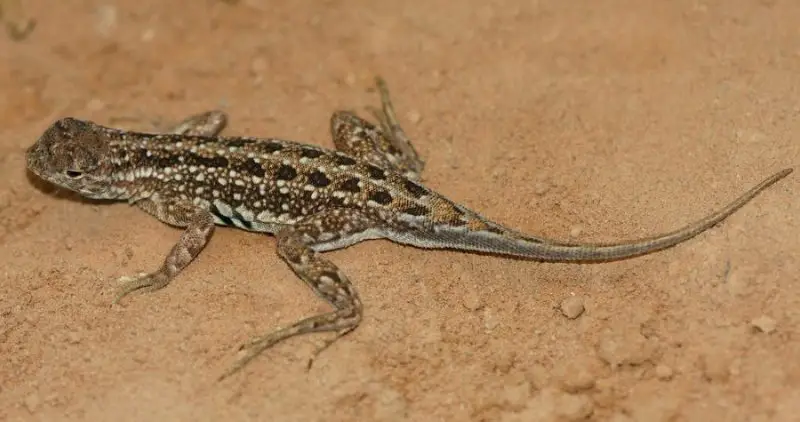
The Lesser earless lizard, or Holbrookia maculata, inhabits the central and southwestern regions of the United States and Mexico. Comprising nine subspecies, including the Mexican, speckled, and northern earless lizards, they lack visible external ears. These lizards thrive in arid habitats, blending into their surroundings with their muted hues.
Elegant Earless Lizard
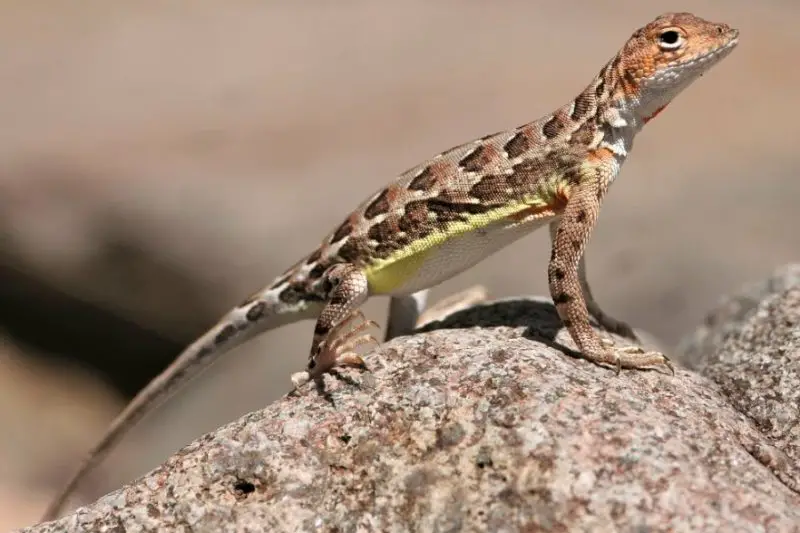
The Elegant earless lizard, known scientifically as Holbrookia elegans, is a petite species indigenous to Mexico and the United States. Typically reaching lengths of around 3 inches, they sport tan or gray hues. Notably, their tails exceed the length of their bodies, contributing to their distinctive appearance.
Texas Horned Lizard
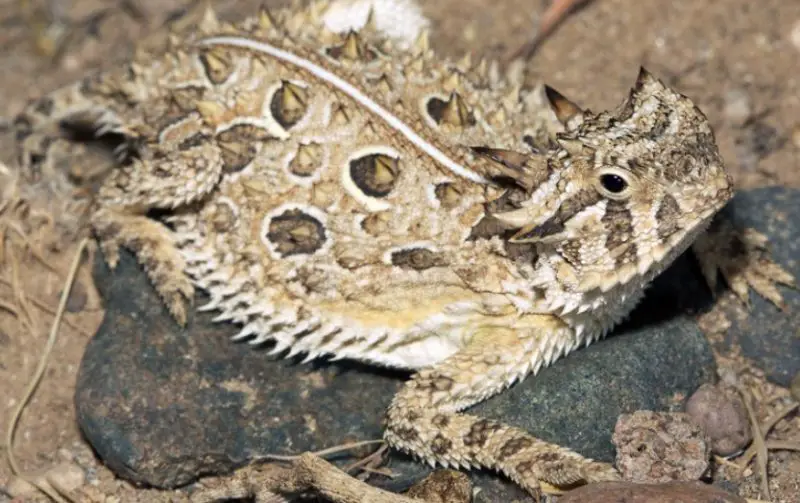
The Texas horned lizard, scientifically named Phrynosoma cornutum or “horny toad,” is the largest and most widespread among the fourteen horned lizard species in the Western United States. Growing up to 2.7 inches from snout to vent, males can reach 3.7 inches and females up to 4.5 inches including their tails. Despite their docile nature, they inflate themselves when threatened, making them difficult to swallow. They possess the unique ability to squirt blood from their eyes, deterring predators with its foul taste and confusing them in the process.
Sonoran Horned Lizard

The Sonoran horned lizard, scientifically termed Phrynosoma goodei, is a medium-sized species measuring around 9cm from snout to vent, tail excluded. Recognizable by three temporal horns on each side of the head and two elongated horns pointing upwards and back, their coloration blends with local substrates, ranging from orange to gray. Typically adorned with two rows of dark spots flanking the dorsal line, though sometimes faint, they feature banded tails, though some lack distinct patterns.
Flat-Tailed Horned Lizard
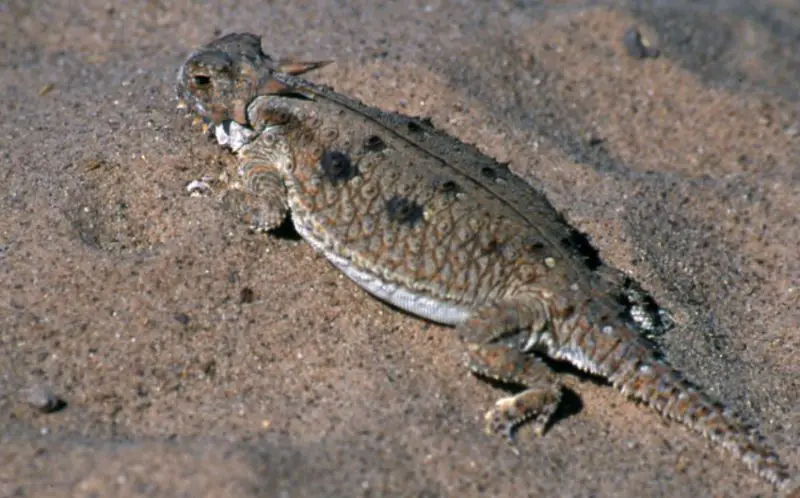
The Flat-tailed horned lizard, scientifically known as Phrynosoma mcallii, is a medium-sized reptile restricted to the Sonoran Desert’s southwestern Arizona region. Characterized by an oval body adorned with pointed scales, they feature smooth skin on their backs with small spines and eight horns extending from the rear of their heads. Their unique ability to blend seamlessly with the desert terrain allows them to conceal their shadow when in the open.
Round-Tailed Horned Lizard
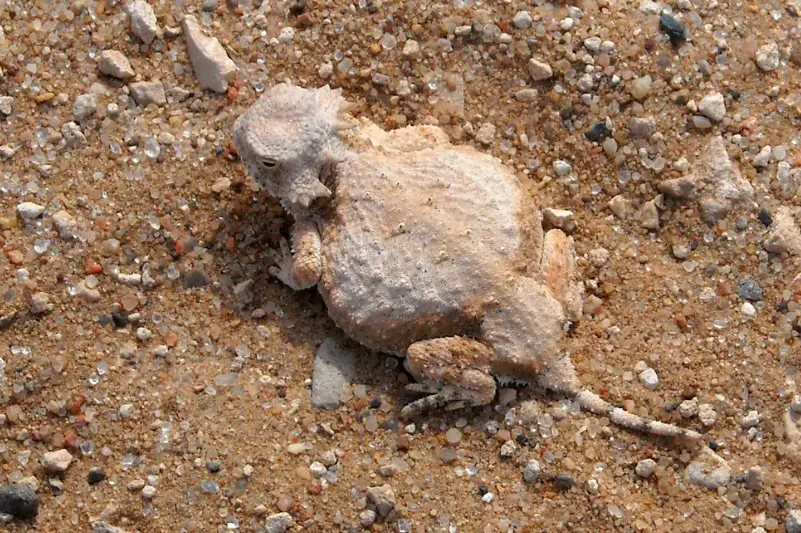
The Round-tailed horned lizard, or Phrynosoma modestum, inhabits semi-arid regions with sparse vegetation, feeding primarily on harvester and honeypot ants. Blending seamlessly with their surroundings, they typically exhibit gray hues, though some may appear pale yellow or light brown. Darker coloring adorns their necks and groins, while some feature stripes on their tails. Measuring up to 4.3 inches (10.5cm) in total length, tail included.
Desert Horned Lizard
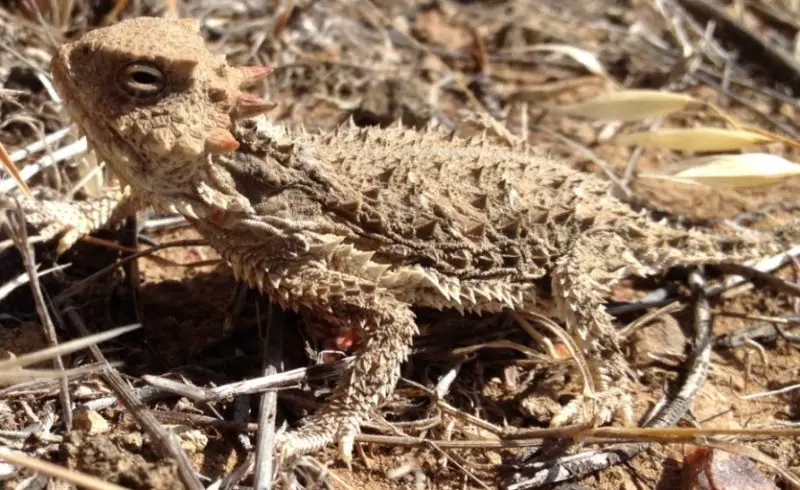
The Desert horned lizard, scientifically labeled Phrynosoma platyrhinos, is identifiable by its flat body and single row of fringe scales on each side. Growing up to 9.5cm (3.75 inches) in total length, they exhibit colors ranging from red/brown to tan or beige, mirroring the surrounding soil. Notably, they feature prominent dark patches on their necks, bordered by gray or light white hues.
Twin-Spotted Spiny Lizard
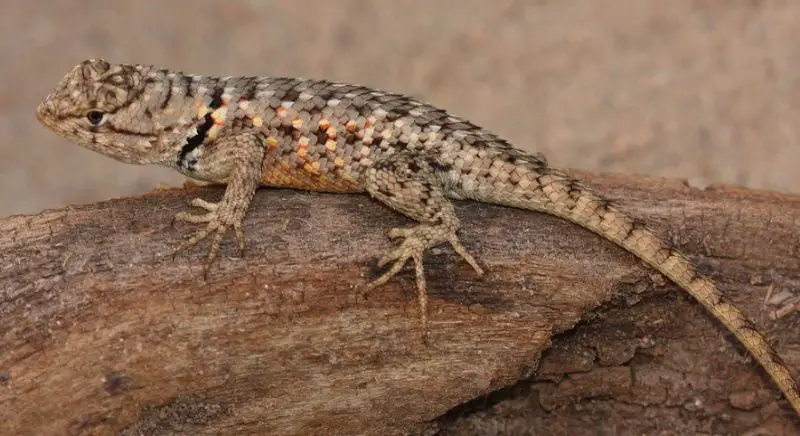
The Twin-spotted spiny lizard, or Sceloporus bimaculosus, is a substantial species measuring 12.1cm, with a tail exceeding double its body length. Distinguished by a row of dark spots flanking the mid-dorsal line, males boast blue patches on their chin, throat, and belly. Females and juveniles lack these distinctive blue markings.
Southwestern Fence Lizard
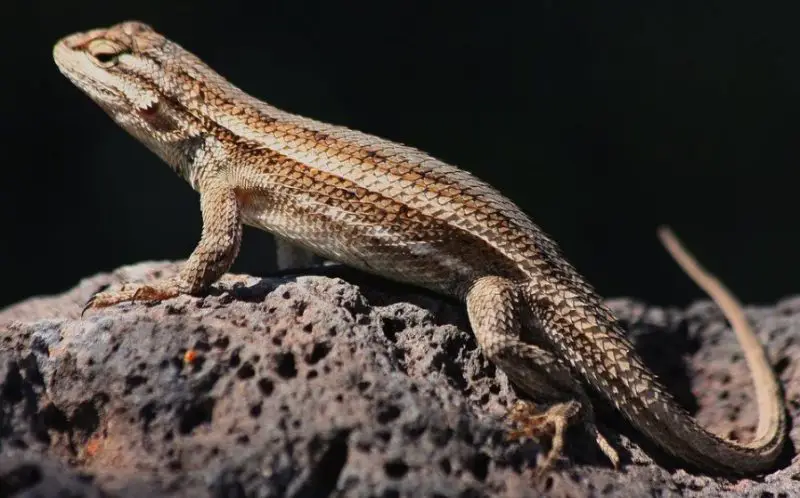
The Southwestern fence lizard, or Sceloporus cowlesi, recognized by its spiny appearance, was first documented in 1956. Endemic to the Chihuahuan Desert, it is a subspecies of the eastern fence lizard. Also known as Cowles’ prairie lizard or White Sands swift, it thrives in arid environments.
Sagebrush Lizard
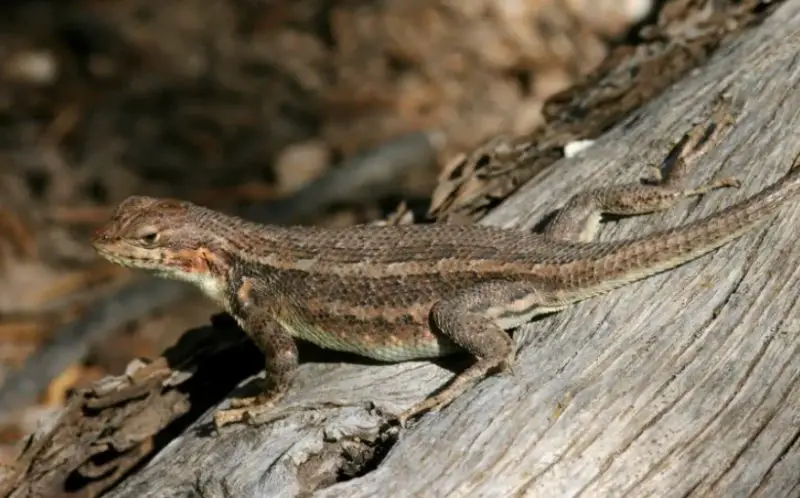
The Sagebrush lizard, scientifically named Sceloporus graciosus, reaches lengths of 3.5 inches (8.9cm) from snout to vent, smaller than the Western fence lizard. Sporting olive, brown, or gray hues, they exhibit green or blue tones in the light. Males feature blue patches on their belly and throat, absent in females and juveniles. During mating season, males display orange coloration. Thriving in forested habitats, they bask on rocky outcrops and logs to absorb sunlight.
Slevin’s Bunchgrass Lizard
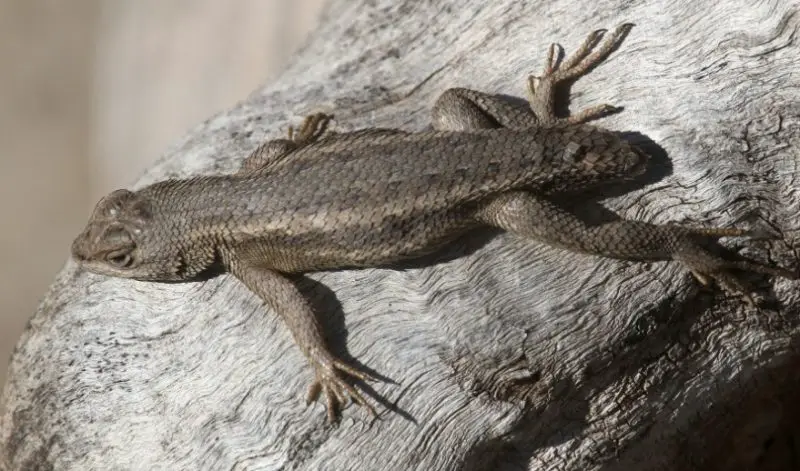
Slevin’s Bunchgrass Lizard, scientifically termed Sceloporus slevini, honors Joseph R. Slevin, a specimen collector. Described in 1937, they inhabit Southeastern Arizona, favoring grassland and forest habitats. Adults measure up to 2.8 inches (7cm) without their tails.
Yellow-Backed Spiny Lizard

The Yellow-backed spiny lizard, or Sceloporus uniformis, is a sizable species reaching lengths of 5.5 inches, tail excluded. Their tails surpass their bodies in length. Sporting tan or brown bodies adorned with black and yellow stripes, they feature a distinctive black collar around the neck. Males, larger than females, boast blue markings on their bellies and throats.
Striped Plateau Lizard
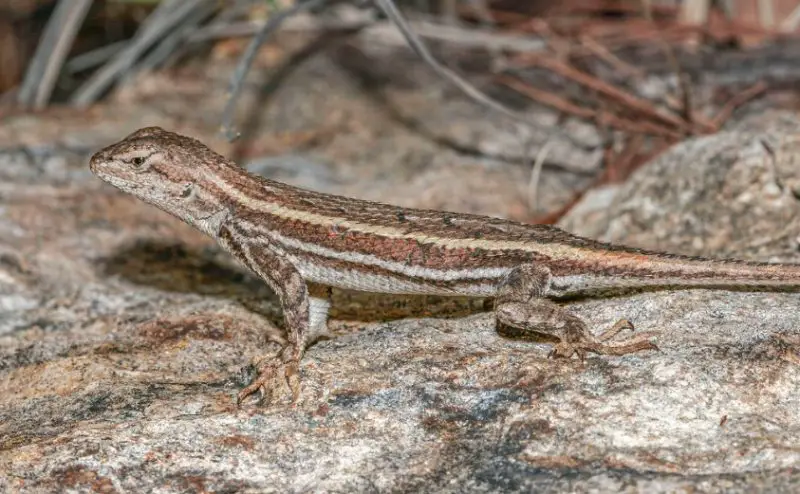
The Striped plateau lizard, scientifically known as Sceloporus virgatus, is a member of the North American spiny lizard family, reaching lengths of up to 4.8cm. Ground-dwelling by nature, they exhibit swift movements across the terrain when startled.
Yuman Fringe-Toed Lizard
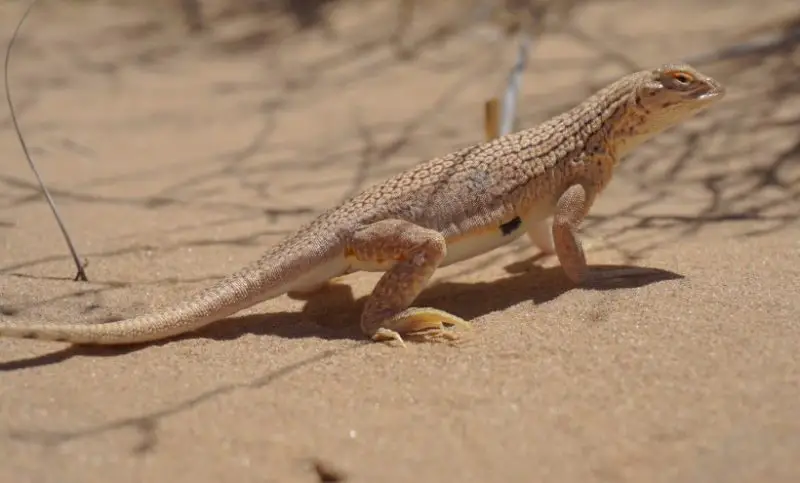
Uma rufopunctata, commonly known as the Yuman fringe-toed lizard, inhabits a restricted region in the southwestern United States and northwestern Mexico, primarily south of the Gila River, particularly in the Yuma and Mohawk dune systems.
Mohave Fringe-Toed Lizard
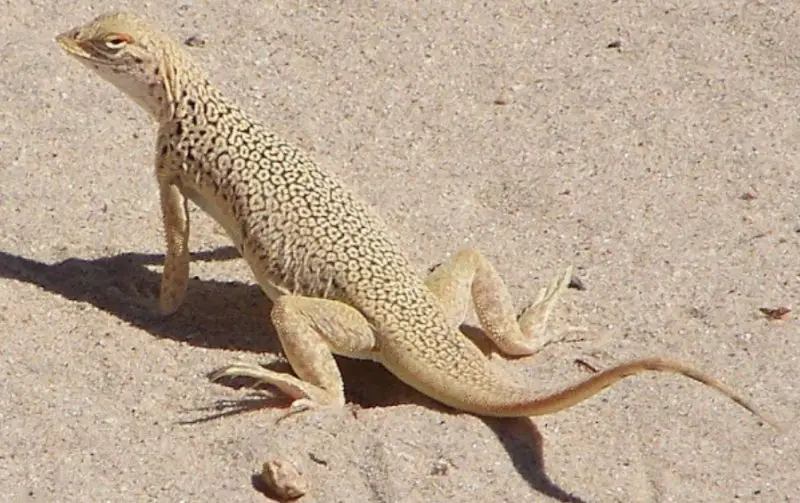
The Mojave fringe-toed lizard, scientifically termed Uma scoparia, boasts smooth, flat bodies in hues ranging from tan brown to gray-white, adorned with black spots on the back for camouflage. Dark banding marks their tails, with additional dark patches on their belly sides. During mating season, their spots turn pink, and their bellies become yellow. Totaling around seven inches, their body and tail are of equal lengths.
Long-Tailed Brush Lizard
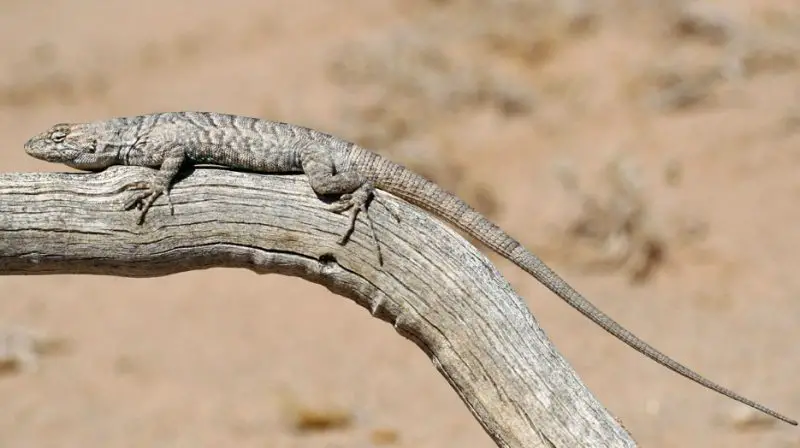
The Long-tailed brush lizard, or Urosaurus graciosus, hails from the Sonoran and Mojave Deserts, spanning Arizona, California, Nevada, and Mexican states. Recognizable by their tails, more than double the body length, they excel at climbing and blend seamlessly with branches, patiently awaiting passing insects.
Mountain Skink

The Mountain skink, or Plestiodon callicephalus, is a medium-sized reptile reaching up to three inches (7.5cm) sans tail. Sporting brown to olive hues with black side stripes, juveniles exhibit bright blue tails, which slightly fade with age, though retaining hints of blue into adulthood. They inhabit diverse habitats, often seeking refuge under leaf litter.
Gilbert’s Skink
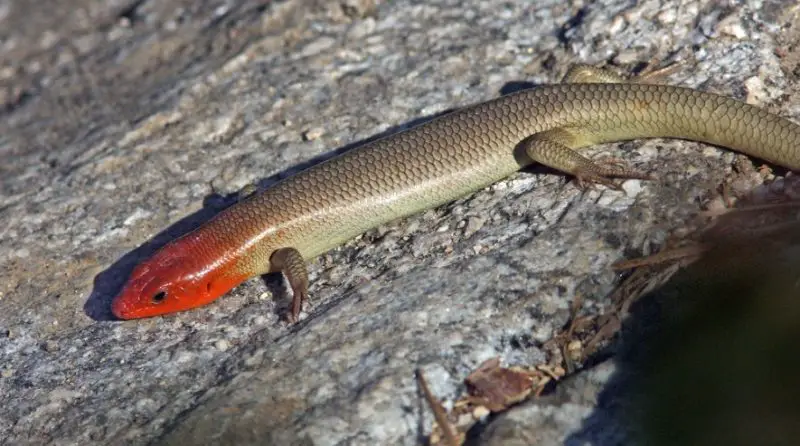
Gilbert’s skink, scientifically named Plestiodon gilbert, inhabits western Arizona, favoring grasslands and pine forests over densely wooded regions. Sporting a sturdy build with small legs, adults display gray, brown, green, or olive hues, while juveniles boast lighter stripes on their sides enclosing a large dark stripe, which fades with age.
Keeled Rock Gecko
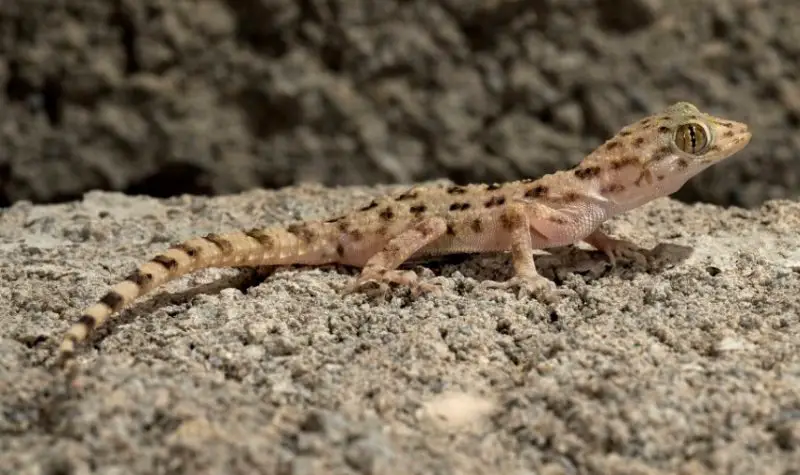
The Keeled gecko, scientifically called Cyrtopodion scabrum, is also known as the rough-tailed gecko. Endemic to Asia, it has been introduced to several countries, including Arizona and Texas in the United States.
Little Striped Whiptail
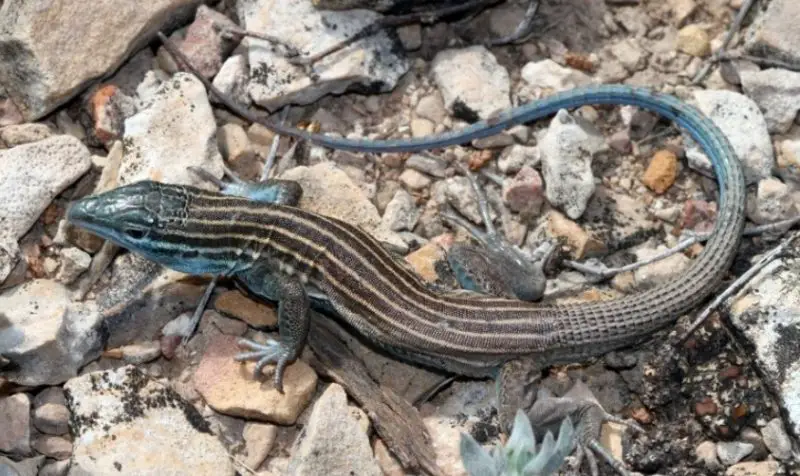
The Little striped whiptail, Aspidoscelis inornatus, reaches lengths of 9.5 inches. Sporting a black body with white or yellow striping extending from head to tail, they also feature blue bellies. Slender with a blue tail twice the body length, males display more blue than females, and stripes may not always be evident. Swift and cautious, they quickly seek cover when threatened.
Mohawk Dunes Fringe-Toed Lizard
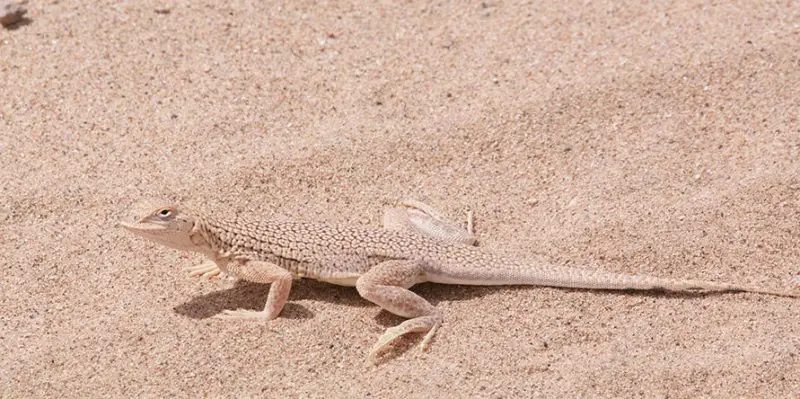
The Mohawk dunes fringe-toed lizard, Uma thurmanae, blends seamlessly into its desert habitat with tan to brown coloring. Notably, they possess fringes on their toes aiding movement through loose sand. Typically found in southwest Arizona’s low desert regions boasting fine, loose sand.
Great Basin Collared Lizard

The Great Basin collared lizard, also known as Crotaphytus bicinctores or the desert collared lizard, boasts a sizable head and hind legs, along with distinctive black bands encircling the neck. Males exhibit larger heads, dark throats, and vibrant orange crossbands across their bodies. Ranging from 2.5 to 4.5 inches from snout to vent, they feature thick tails double the length of their bodies.
Sonoran Collared Lizard
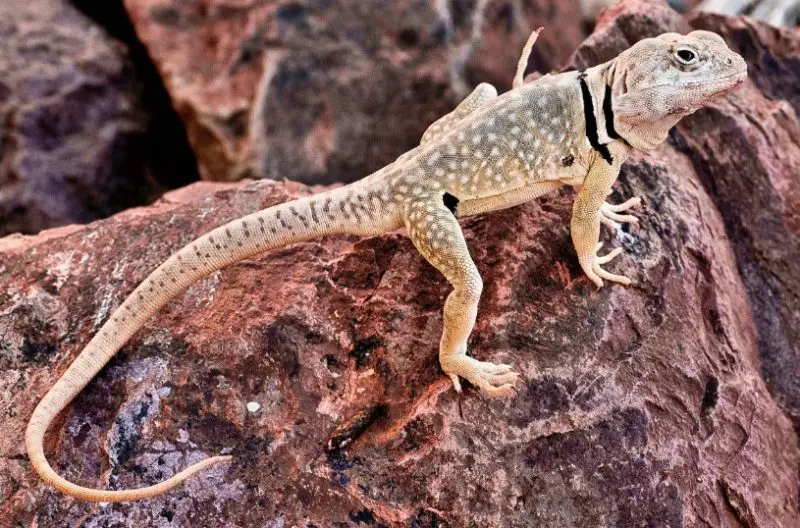
The Sonoran collared lizard, scientifically termed Crotaphytus nebrius, is native to Arizona and Sonora, Mexico. Sporting hues ranging from gray to yellow, they feature distinctive grey/white spots, smaller on their sides and enlarging along the center of their backs. Primarily active during spring and summer, they inhabit arid regions, blending seamlessly with their desert surroundings.
Long-Nosed Leopard Lizard

The Long-nosed leopard lizard, or Gambelia wislizenii, displays cream, white, or gray hues adorned with brown or dark gray spots across their heads and bodies, sometimes featuring dark bars along their backs and tails. Juveniles may exhibit rust coloring, bright red spots, and yellow accents.
Many-Lined Skink
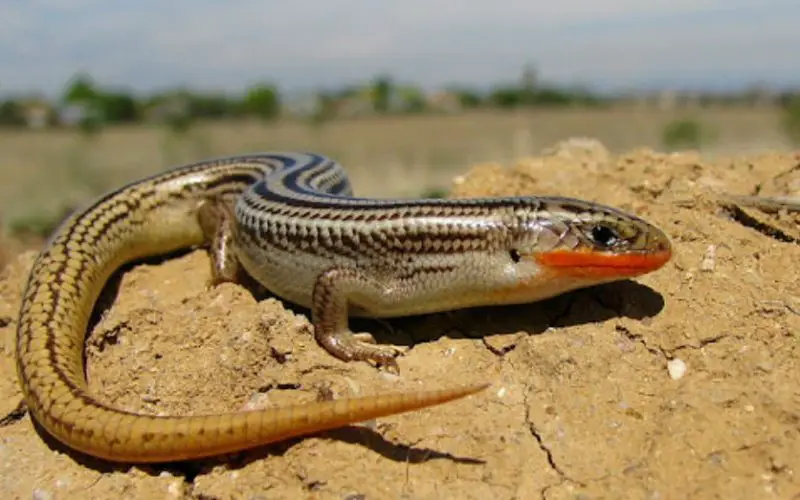
The Many-lined skink, also known as Plestiodon multivirgatus or northern many-lined skink, attains a length of approximately 12 inches (19cm), tail included. Medium-sized with brown to olive bodies, they feature prominent black stripes spanning the tail and body. Thriving in rocky habitats, they blend seamlessly into their surroundings.
Great Plains Skink
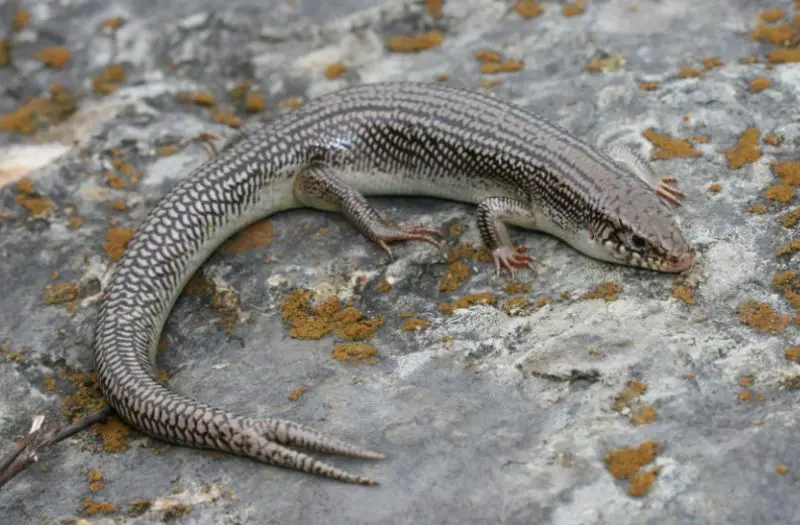
The Great Plains skink, scientifically termed Plestiodon obsoletus, is a sizable reptile reaching 14cm in length sans tail. Adorned in gold, green/gray, or yellow hues with a net-like pattern, they feature shiny scales. Their tails exceed one and a half times their body length. Males possess broader heads than females. Hatchlings sport black bodies with dark blue tails, with coloration lightening as they mature.
Western Skink
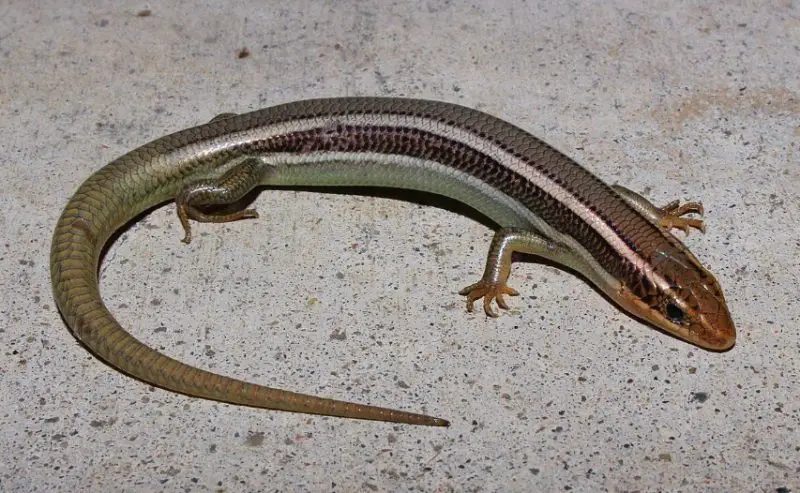
The Western skink, scientifically labeled Plestiodon skiltonianus, thrives in diverse habitats but favors open, moist areas, frequently spotted on dry hillsides. Preferring woodlands, open pine forests, and grasslands with moist sand, they feature a black to brown band extending from the side of the head to beyond the hind legs, bordered by a white to beige stripe.
Arizona Striped Whiptail
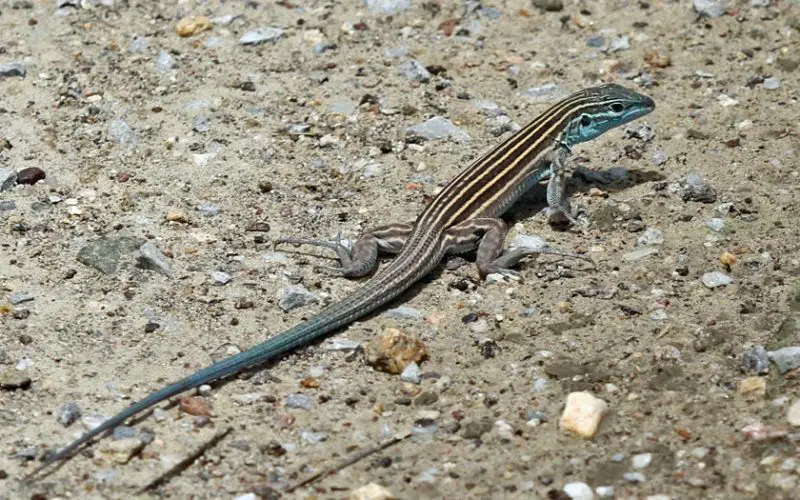
The Arizona striped whiptail, or Aspidoscelis arizonae, is native to the United States, particularly in Arizona’s grassy desert regions, often amidst desert shrubs. Measuring 2.8 inches in length, they feature long, whip-like tails. With brown and blue bodies adorned with yellow stripes, they swiftly evade threats, displaying remarkable speed and agility. This distinct coloration helps differentiate them from the Pai striped whiptail.
Canyon Spotted Whiptail
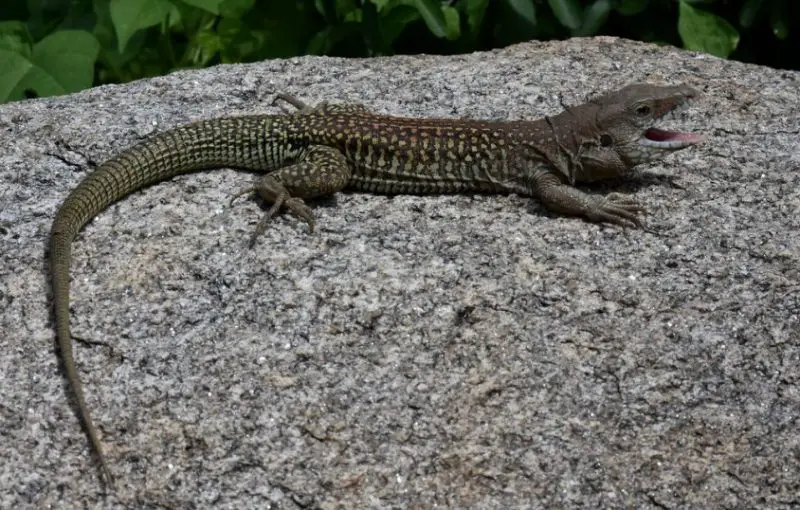
The Canyon spotted whiptail, or Aspidoscelis burti, inhabits Arizona and Mexico. Identified by their tan hue with white stripes and spots, they exhibit a shy demeanor, excelling at hiding. Consequently, sightings in Arizona are limited due to their elusive nature.
Chihuahuan Spotted Whiptail
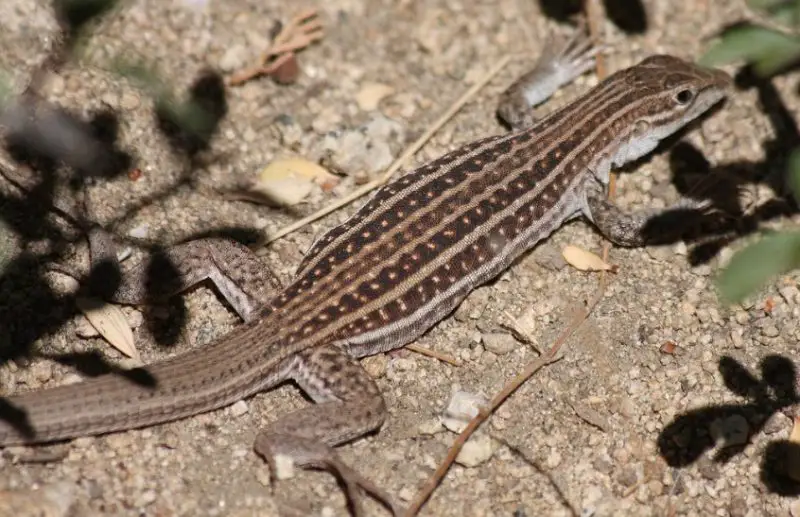
The Chihuahuan spotted whiptail, Aspidoscelis exsanguis, is a medium-sized, all-female lizard reaching lengths of up to 10.7cm sans tail. Sporting stripes and spots, they feature light stripes that may fade with age, but remain visible on their necks.
Gila Spotted Whiptail
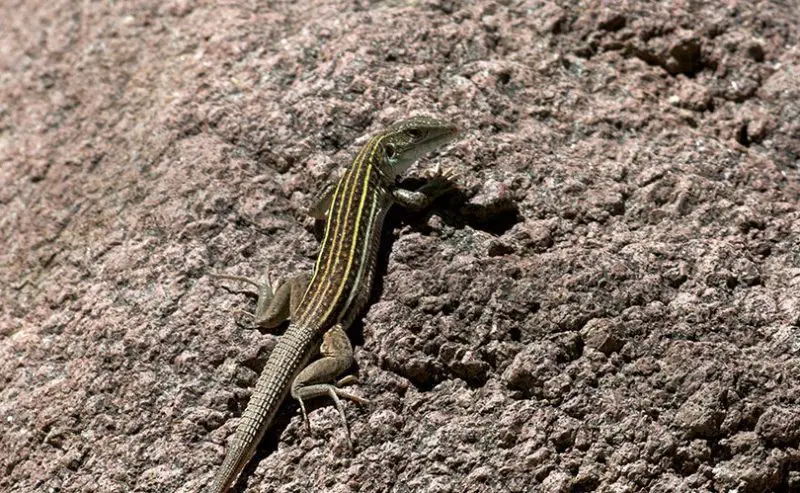
The Gila spotted whiptail, Aspidoscelis flagellicauda, is a Sonoran lizard dwelling in Arizona, New Mexico, and Mexico. Recognizable by their shy demeanor, they swiftly flee when threatened, displaying remarkable speed.
New Mexico Whiptail
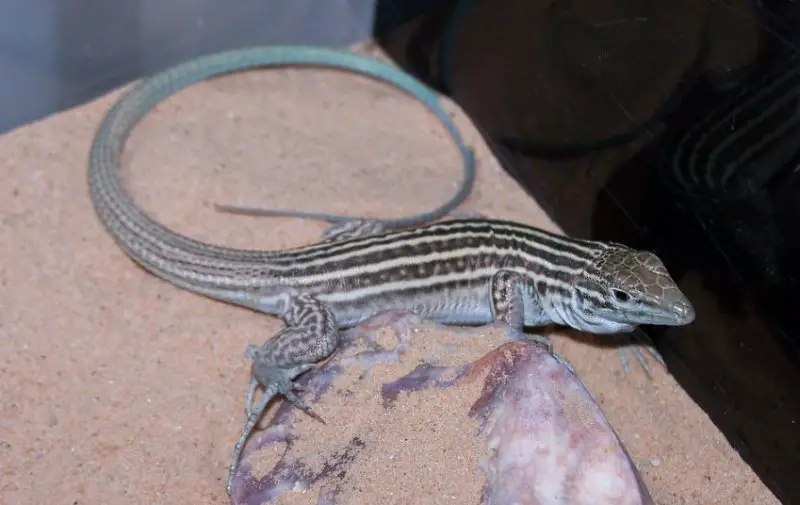
The New Mexico whiptail, Aspidoscelis neomexicana, reaches lengths of up to 9.1 inches (23cm). Identified by their brown to black bodies with seven pale yellow stripes, they feature light-colored spots between these stripes. Their bellies are white or pale blue, while throats display shades of blue or blue/green. Possessing a slender body and long tail, they exhibit a wary demeanor, darting for cover when approached.
Pai Striped Whiptail
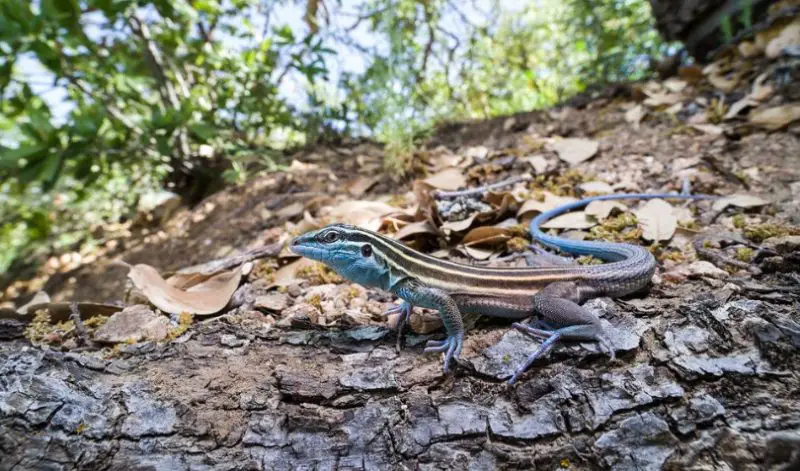
The Pai striped whiptail, Aspidoscelis pai, shares similarities with the Arizona striped whiptail, often causing confusion. Endemic to Arizona, they belong to the Aspidoscelis genus.
Plateau Striped Whiptail
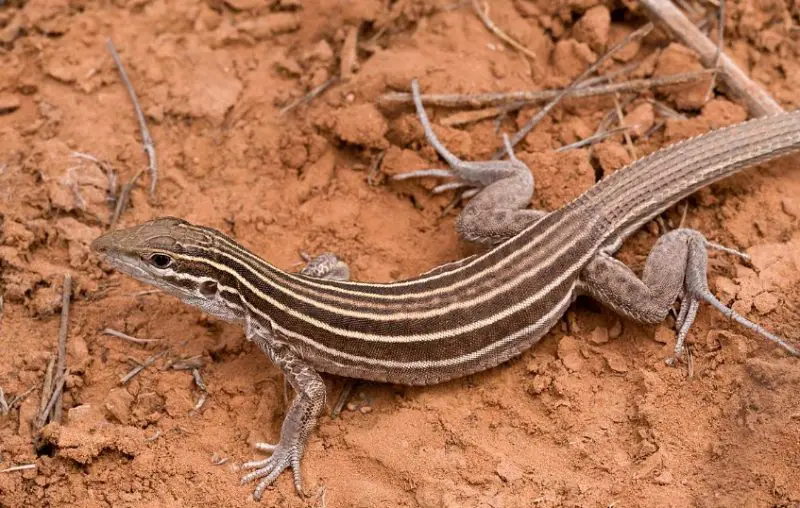
The Plateau striped whiptail, Aspidoscelis velox, is part of the quamata species in the New World runner’s family. Ground-dwelling and swift, they exhibit a wary demeanor, readily fleeing when approached.
Red-Backed Whiptail
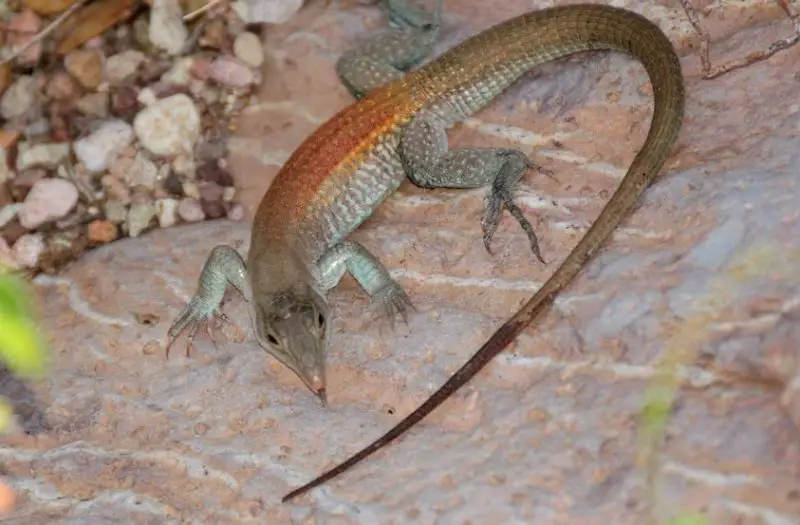
The Red-backed whiptail, Aspidoscelis xanthonota, is a visually striking lizard found in limited areas of the United States, notably south-central Arizona. Due to their elusive nature, sightings of these lizards are rare, making encountering one a special occasion.
Arizona Night Lizard

The Arizona night lizard, scientifically known as Xantusia arizonae, reaches lengths of about 10cm. Identified by dark spots on their sides and large eyes, they favor seclusion. Mostly active in summer and spring, they remain secretive, seldom seen by observers.
Bezy’s Night Lizard
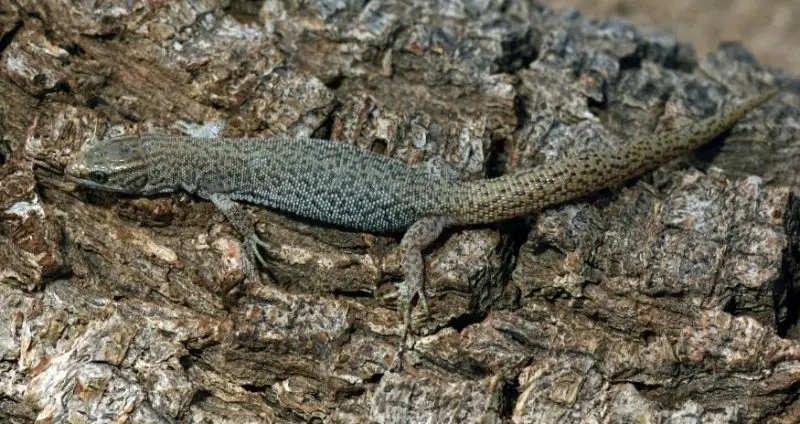
Bezy’s night lizard, scientifically termed Xantusia bezyi, is a small, smooth-skinned reptile, yellow/brown or gray/brown in color, reaching up to 7cm sans tail. Featuring flat heads and dark patches on their backs, they favor pine woodlands and desert highlands, finding refuge beneath rocks.
Desert Night Lizard
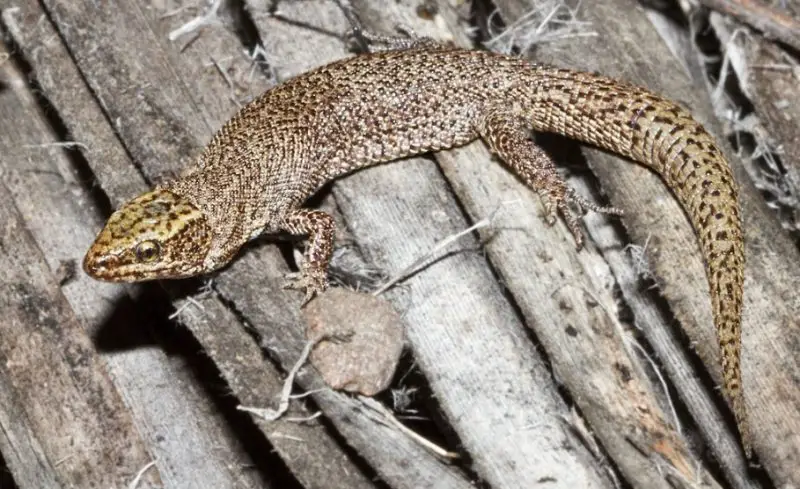
The Desert night lizard, scientifically named Xantusia vigilis, reaches up to 7cm in body length, with a tail of similar length. Sporting yellow/brown, olive, or gray hues, they possess the ability to alter their color from light olive to dark brown, aiding in sun absorption. Excellent climbers, they consume various insects and prefer semi-arid habitats, maintaining a secretive nature.
Giant Spotted Whiptail
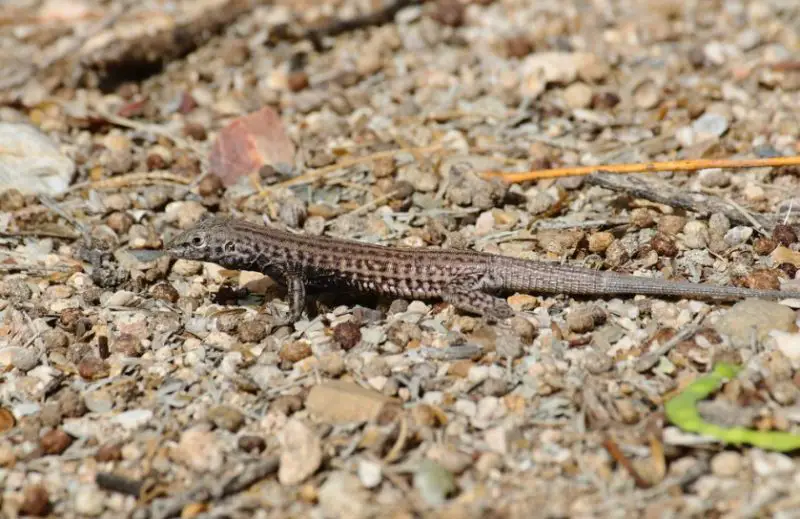
The Giant spotted whiptail, Aspidoscelis stictogrammus, inhabits Arizona, boasting a substantial size of up to 51cm, tail included. Identified by a pointed head, elongated body, and tail, they are notable for their large stature among whiptail species.
Ornate Tree Lizard

The Ornate Tree Lizard, scientifically known as Urosaurus ornatus, can be identified by its size of up to 2.3 inches (5.9 cm) from snout to vent. Males have turquoise bellies and vary in color. In Arizona, males show either an orange throat with a blue center or a solid orange dewlap, with the orange-blue combination being more aggressive and territorial.
Common Side-Blotched Lizard
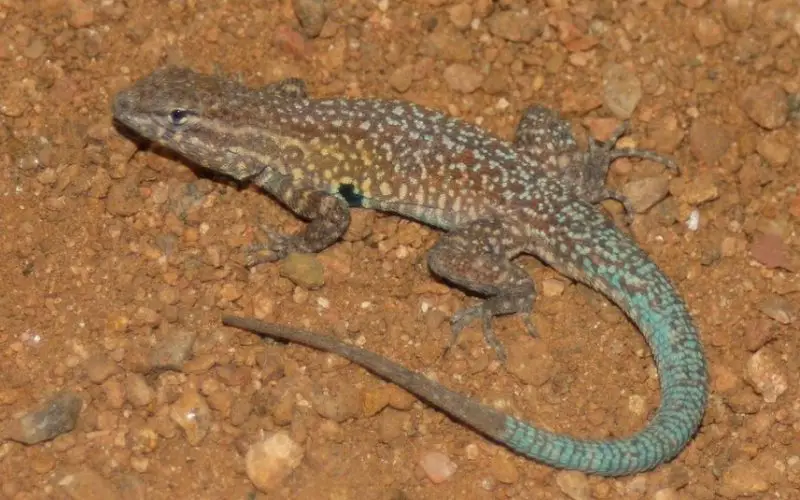
Common side-blotched lizards (Uta stansburiana) inhabit dry regions and have three morphs competing for mates. Males grow up to 2.4 inches (6cm), females are smaller. Males may have blue tails and backs with yellow or orange sides; females have back stripes. Both sexes feature a side blotch behind the front limbs.
Desert spiny lizards

Desert spiny lizards (Sceloporus magister) are common in Arizona, growing up to 5.6 inches. Adults have blue patches on their dewlap and belly, with green or blue sides and tails. Juveniles and females have dark spots on their backs and tummies. Both sexes have brown or yellow shoulder spots.
Yarrow’s Spiny Lizard
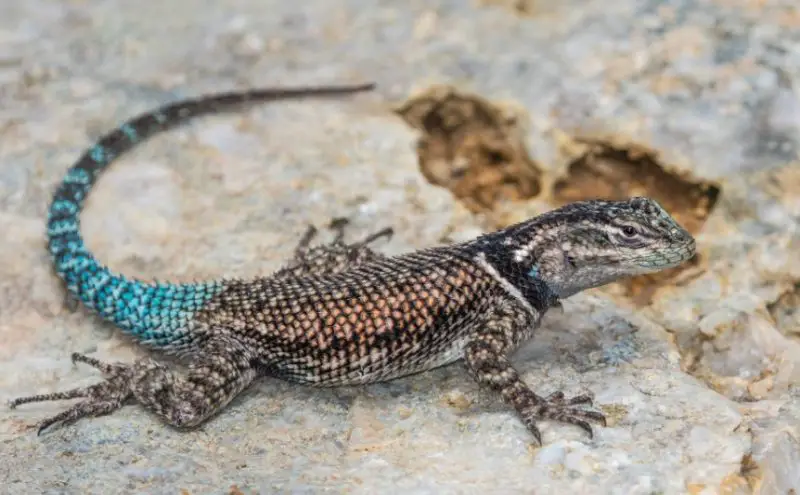
Yarrow’s spiny lizard (Sceloporus jarrovii) prefers forests and rocky areas. Growing up to 4.1 inches (10.5 cm), they have a cross pattern on their bodies. Colors range from green and blue to pink and copper, with dark gray on their heads. Males have blue bellies and throats.
Zebra-Tailed Lizard
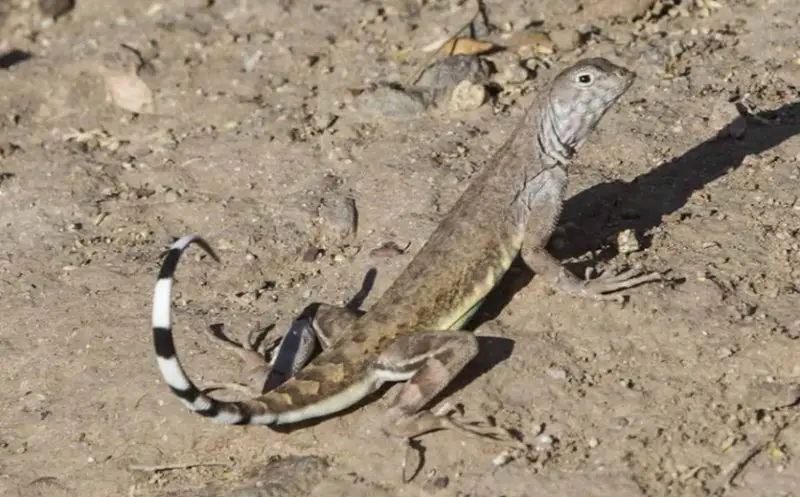
The zebra-tailed lizard (Callisaurus draconoides) prefers open deserts with hard soil and limited vegetation. Growing up to 4 inches (10.2 cm), they are light brown to gray with dark gray spots on their backs and black cross bands on their tails. Males have black side blotches extending to blue on their tummies.
Greater Short-Horned Lizard
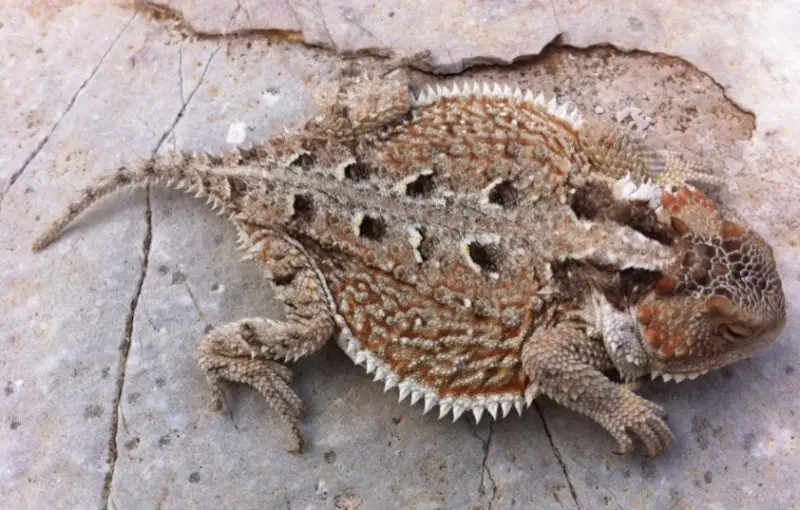
Greater short-horned lizards (Phrynosoma hernandesi) have flat bodies, short spines on their heads, short legs, and a snub nose. They grow to around 6 inches (15 cm), with males smaller than females. These “sit and wait” predators feed mainly on ants. When threatened, they can squirt blood from their eyes to deter predators.
Plateau Fence Lizard
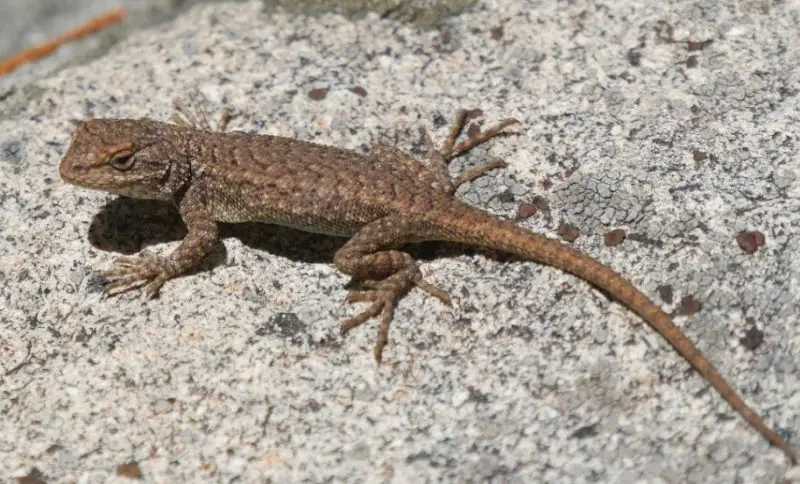
The plateau fence lizard (Sceloporus tristichus) has spiny scales with colors ranging from green to brown and gray, and dark brown cross bands. They feature metallic blue patches on their bellies and throats, with males having brighter patches. Males average 2.9 inches (7.5 cm) from snout to vent. They prefer rocky areas like canyon walls and hillsides.
Western Whiptail
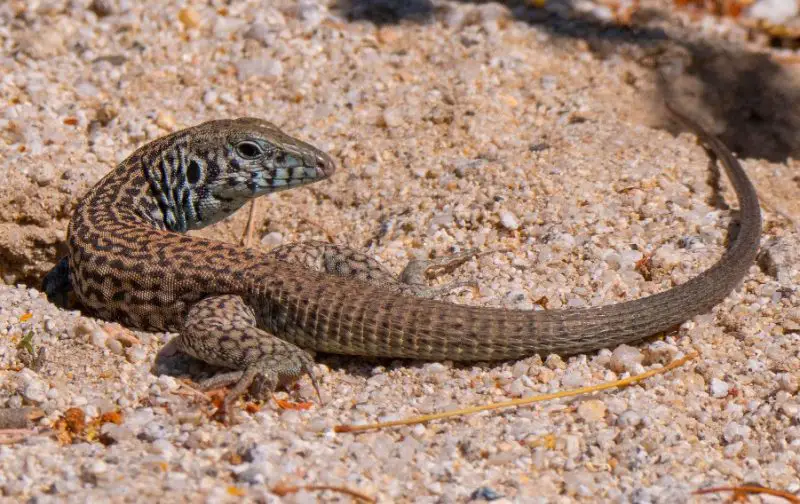
The Western whiptail (Aspidoscelis tigris) is common in the southwestern U.S. and northern Mexico. They inhabit shrublands, deserts, and sparse vegetation areas, often seen in open dry forests and woodlands. These slender lizards have grainy scales and light stripes on their upper side, with pink or orange dewlaps in adults. They can reach up to 12 inches (30 cm) in length, with a snout-to-vent length of 4 inches (10 cm). Newborns are orange to yellow with black or brown stripes or spots.
Clark’s Spiny Lizard
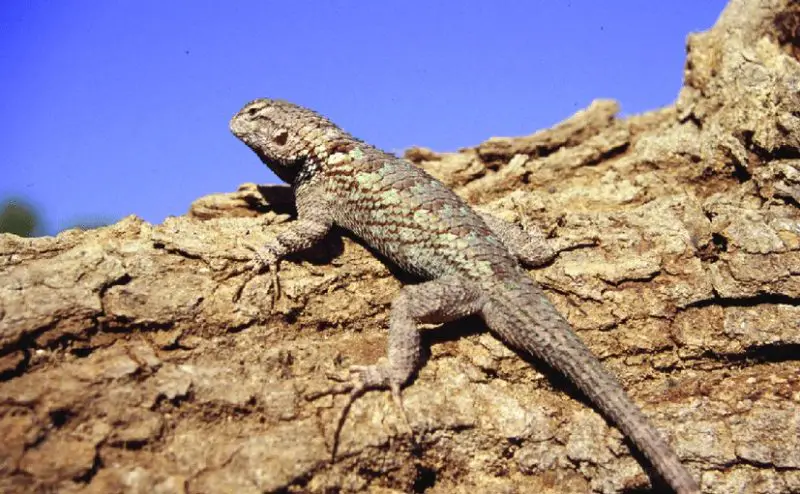
Clark’s spiny lizard (Sceloporus clarkii) is a medium to large reptile, growing up to 5.25 inches (12.8 cm) from snout to vent. They have pointed scales with a gray, blue, or tan base, a purple stripe down their back, and single yellow scales on the sides. Males have a blue dewlap and tummy, while females have red to orange heads during mating season. They inhabit semi-arid and arid regions, mountain slopes, rocks, and sometimes trees, often found under boulders.
Gila Monster
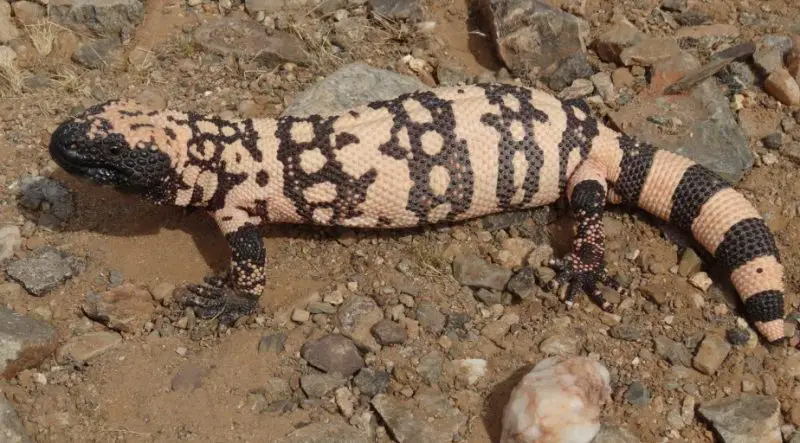
The Gila monster (Heloderma suspectum) is the only poisonous lizard in Arizona, growing up to two feet (60 cm). It’s slow-moving and not a real threat to humans, with black scales and yellow to pink markings. Males have larger triangular heads compared to females. Preferring succulent deserts, woodlands, and scrublands, they hide in burrows or under rocks and soak in puddles after rains. Their venom is as toxic as that of the Western diamondback rattlesnake, causing pain, weakness, and edema.
Greater Earless Lizard
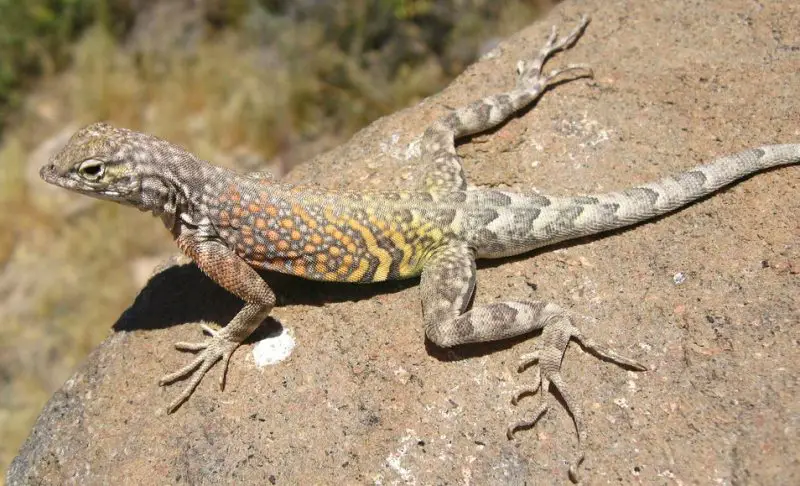
The greater earless lizard (Cophosaurus texanus) grows up to seven inches (18 cm), with males larger than females. Males have two black stripes in front of their hind legs; females have one behind each thigh. They possess two throat folds, large eyes, and can hear despite lacking external ear openings. Active during the day, they hibernate in winter. When threatened, they wag their tails, perform push-ups, head bob, and compress their bodies. They have a blood sinus on their head, enabling them to spray blood at predators to escape.
Western Banded Gecko
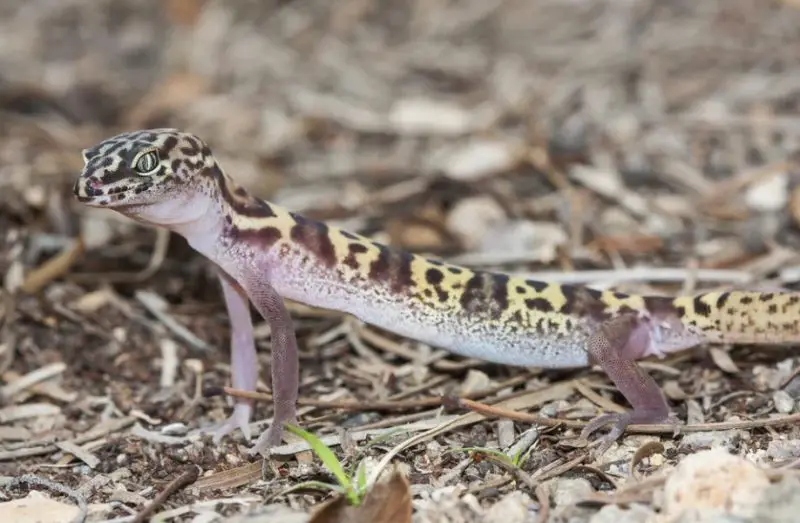
The Western banded gecko (Coleonyx variegatus) reaches up to six inches (15 cm) in length, with a sandy-colored body featuring dark cross bands and movable eyelids. Found in deserts, woodlands, and grasslands, they hunt small spiders and insects at night. When threatened, they may break their tails or lift them to mimic scorpions and deter predators.
Regal Horned Lizard
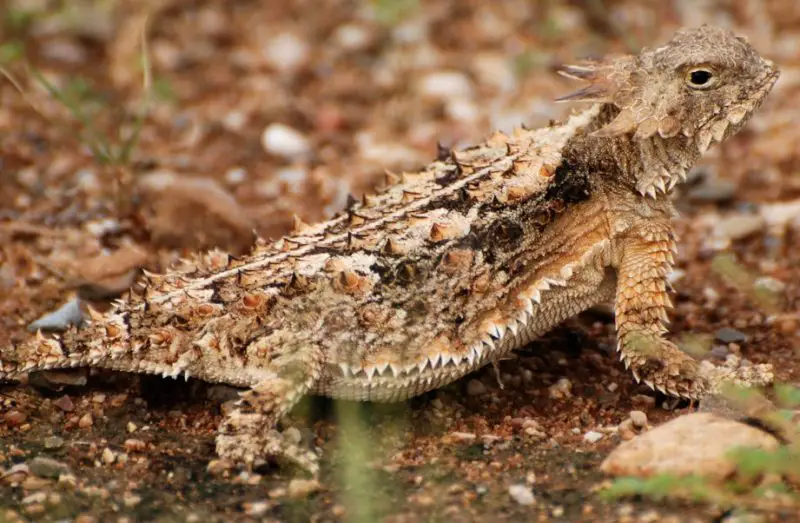
The regal horned lizard (Phrynosoma solare) is a small, flat lizard with spikes all over its body, featuring a prominent regal horn. It can reach up to four inches (11 cm) from snout to vent and has a yellow/brown or gray coloration with red blotches. Found in southeastern Arizona, they prefer gently sloping, sparsely vegetated terrain in hot and dry climates.
Sonoran Spotted Whiptail
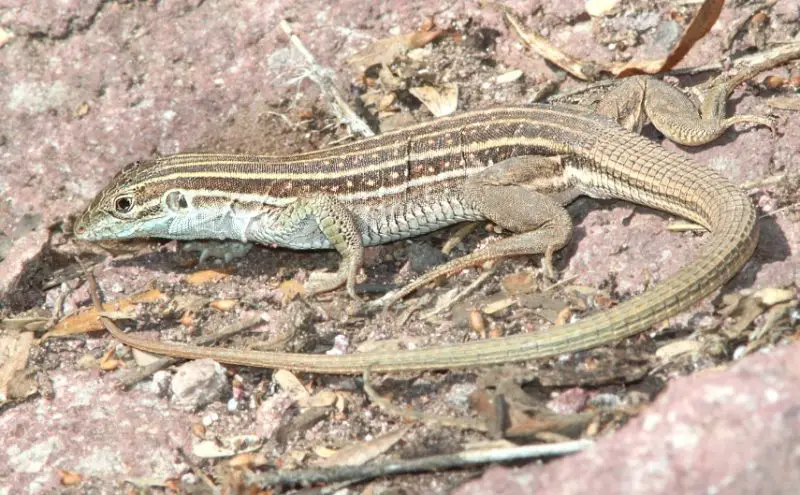
The Sonoran spotted whiptail (Aspidoscelis sonorae) is a medium-sized lizard, growing up to 3.5 inches from snout to vent and 12 inches in total length. They have a pointed snout and thin body, black to brown with six yellow stripes. Found in grasslands, woodlands, and desert shrubs.
Common Chuckwalla
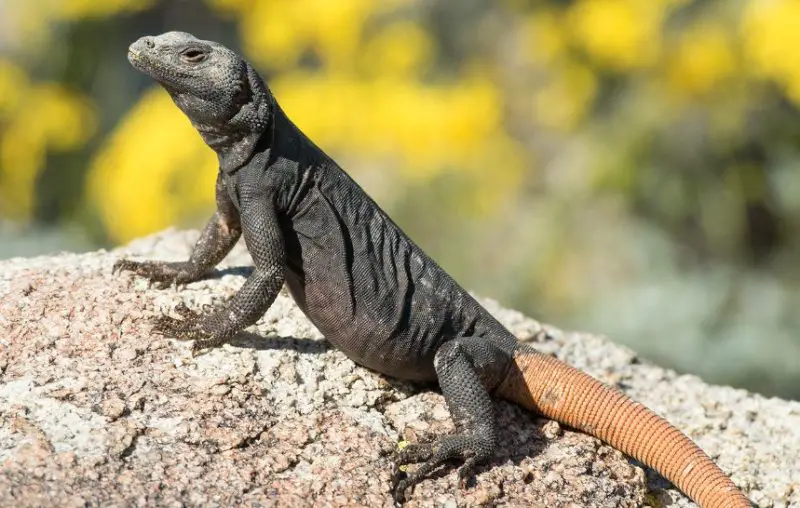
The common chuckwalla (Sauromalus ater) is a large lizard with a flat body, rounded tummy, and blunt-tipped tail, reaching up to 20 inches in length and weighing up to 9kg. They have small scales covering the body and larger scales protecting the ear openings. Adult males have black heads, pelvic regions, and shoulders, with a light tan mid-body and brown speckles, while females are brown with dark red spots. Juveniles have broad bands on their bodies and tails, which fade with age. They hide in rock crevices to avoid predators and bask in the morning sun.
Mediterranean House Gecko
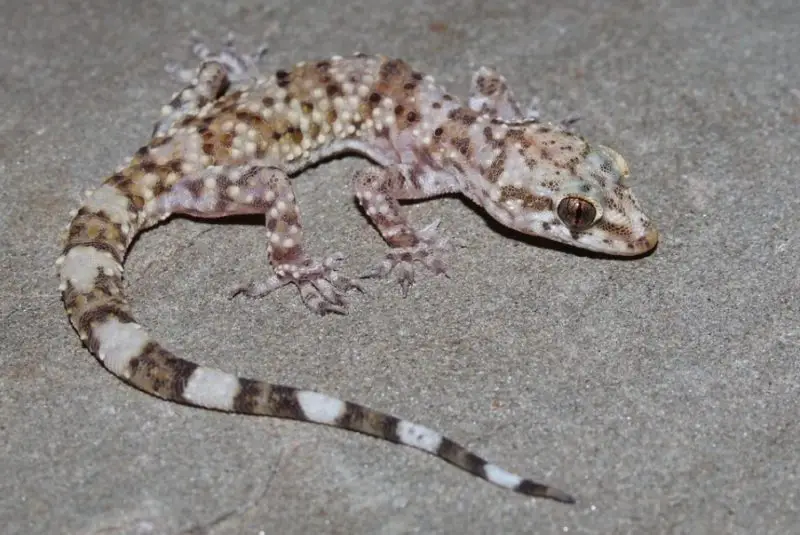
The Mediterranean house gecko (Hemidactylus turcicus) is small, reaching up to 5.9 inches (15 cm), with large eyes lacking eyelids, tan skin, and black spots. Some have tail stripes. They possess rounded snouts, concave foreheads, ear openings, and moderate-sized bodies and limbs. Their depressed, cylindrical tails taper at the end. Some are translucent with visible spots, while others appear darker. They seek darkness to escape predators.
Eastern Collared Lizard
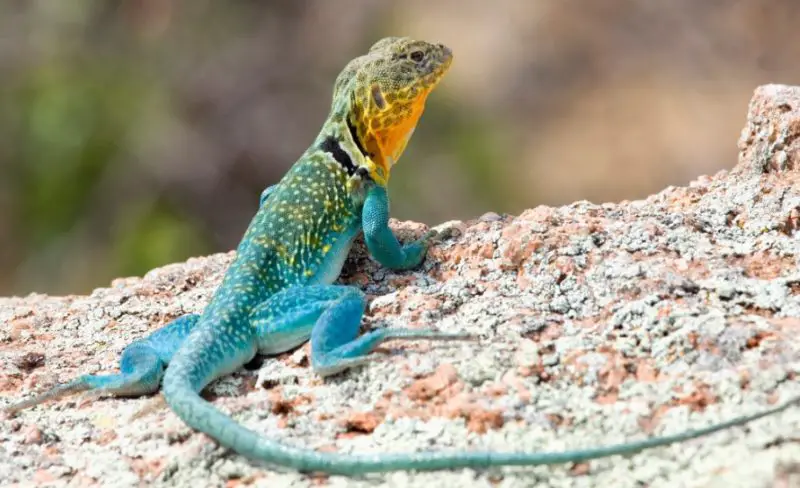
The Eastern collared lizard (Crotaphytus collaris) is recognized by its two black bands around the neck. Adults have green scales with yellow, blue, brown, and olive hues; females are duller. Both sexes have large heads and white bellies. They’re adept at running on their hind legs, covering strides three times their body length. Preferring rocky areas, they inhabit grasslands, desert shrubs, and sagebrush.






